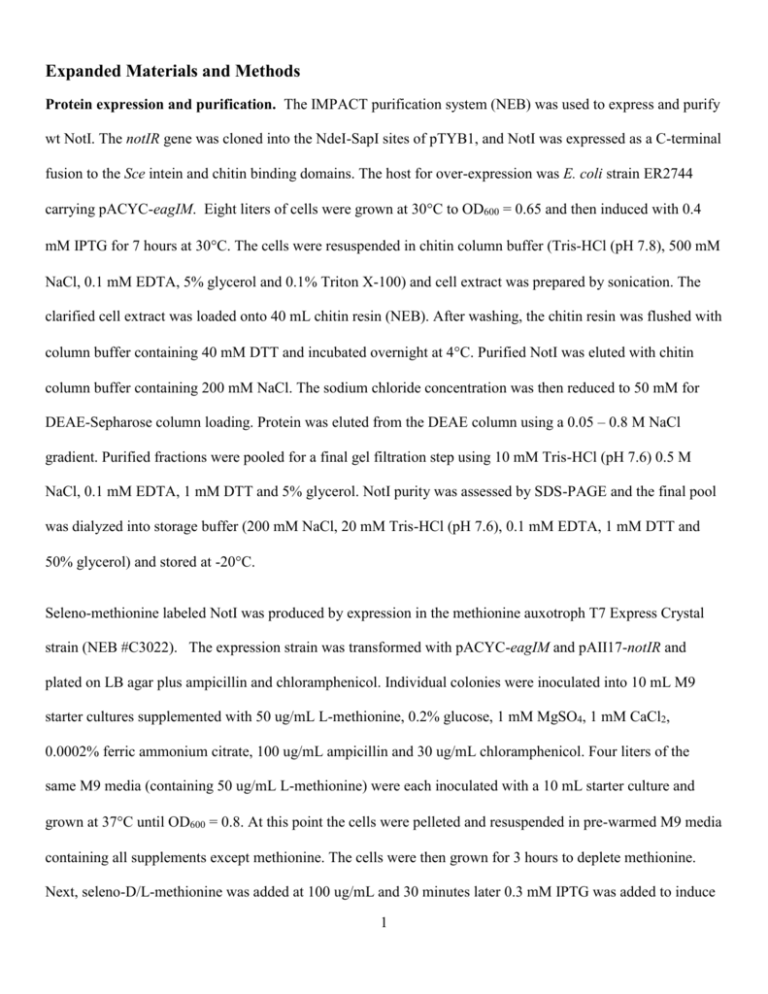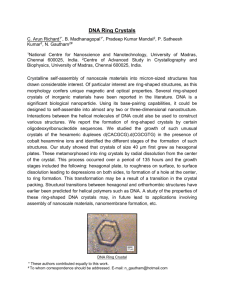purity edta
advertisement

Expanded Materials and Methods Protein expression and purification. The IMPACT purification system (NEB) was used to express and purify wt NotI. The notIR gene was cloned into the NdeI-SapI sites of pTYB1, and NotI was expressed as a C-terminal fusion to the Sce intein and chitin binding domains. The host for over-expression was E. coli strain ER2744 carrying pACYC-eagIM. Eight liters of cells were grown at 30C to OD600 = 0.65 and then induced with 0.4 mM IPTG for 7 hours at 30C. The cells were resuspended in chitin column buffer (Tris-HCl (pH 7.8), 500 mM NaCl, 0.1 mM EDTA, 5% glycerol and 0.1% Triton X-100) and cell extract was prepared by sonication. The clarified cell extract was loaded onto 40 mL chitin resin (NEB). After washing, the chitin resin was flushed with column buffer containing 40 mM DTT and incubated overnight at 4C. Purified NotI was eluted with chitin column buffer containing 200 mM NaCl. The sodium chloride concentration was then reduced to 50 mM for DEAE-Sepharose column loading. Protein was eluted from the DEAE column using a 0.05 – 0.8 M NaCl gradient. Purified fractions were pooled for a final gel filtration step using 10 mM Tris-HCl (pH 7.6) 0.5 M NaCl, 0.1 mM EDTA, 1 mM DTT and 5% glycerol. NotI purity was assessed by SDS-PAGE and the final pool was dialyzed into storage buffer (200 mM NaCl, 20 mM Tris-HCl (pH 7.6), 0.1 mM EDTA, 1 mM DTT and 50% glycerol) and stored at -20C. Seleno-methionine labeled NotI was produced by expression in the methionine auxotroph T7 Express Crystal strain (NEB #C3022). The expression strain was transformed with pACYC-eagIM and pAII17-notIR and plated on LB agar plus ampicillin and chloramphenicol. Individual colonies were inoculated into 10 mL M9 starter cultures supplemented with 50 ug/mL L-methionine, 0.2% glucose, 1 mM MgSO4, 1 mM CaCl2, 0.0002% ferric ammonium citrate, 100 ug/mL ampicillin and 30 ug/mL chloramphenicol. Four liters of the same M9 media (containing 50 ug/mL L-methionine) were each inoculated with a 10 mL starter culture and grown at 37C until OD600 = 0.8. At this point the cells were pelleted and resuspended in pre-warmed M9 media containing all supplements except methionine. The cells were then grown for 3 hours to deplete methionine. Next, seleno-D/L-methionine was added at 100 ug/mL and 30 minutes later 0.3 mM IPTG was added to induce 1 NotI expression overnight. Seleno-methionine labeled NotI was purified as described for wt NotI except that Heparin HyperD (BioSepra) chromatography substituted for the chitin column step. Seleno-methionine incorporation was assessed by mass spectrometry (J. Benner, NEB). The mass analysis indicated that greater than 90% of the protein molecules contained seleno-methionine at all 6 positions. Specific activity of the selenium labeled protein is comparable to the specific activity of wt NotI. Crystallization . Unlabeled protein was dialyzed into crystallization buffer (5% glycerol, 50 mM Tris-HCl pH 7.6, 20 mM NaCl, 1 mM DTT, 1 mM CaCl2) and concentrated to ~10 mg/mL. Crystallization experiments were carried out using vapor diffusion with hanging-drop geometry. Initial sparse matrix crystallization screens were conducted with a series of DNA duplexes varying in length and cohesive overhang. Optimized crystallization conditions based off of initial hits yielded two different crystal forms. The first crystal form (Form #1), containing a DNA-bound complex, was grown at 4°C with 6-8 mg/mL protein, in 29-39% PEG 4000, 130-240 mM LiSO4, 100mM Tris HCl pH 8.5, and in the presence of a 2:1 molar ratio of a 22bp blunt-ended DNA duplex (DNA:protein dimer). DNA duplexes were prepared by mixing equimolar amounts of two DNA oligos, 5’-CGGAGGCGCGGCCGCGCCGCCG-3’ and 5’CGGCGGCGCGGCCGCGCCTCCG-3’, heating at 95°C for 10 minutes, and then gradually cooling under thermal cycler control to 25°C over six hours. Yellow-colored crystals of the space group P21 grew after one week. Crystals were briefly dipped in paraffin oil for cryoprotection prior to freezing in liquid nitrogen. The second crystal form (Form #2), containing unbound protein, was grown at room temperature with 6 mg/mL protein in 2.0 M (NH4)2SO4, 100 mM MES pH 6.5, 10 mM CaCl2, and 20 mM NaCl. A 1.5:1 molar ratio of a 12 bp blunt-ended DNA duplex was also present in the initial crystallization experiments, but the DNA was not visible in the resulting electron density maps. Subsequent experiments demonstrated that the DNA was not essential for growth of this crystal form, but greatly facilitated growth via an indirect (presumably buffering) effect. Deep yellow crystals of the space group P43212 grew sporadically amidst heavy protein precipitation 2 after 1-2 weeks. Improved efficiency in crystal growth was achieved using both micro- and macroseeding techniques. Artificial mother liquor (2.25 M (NH4)2SO4, 100 mM MES pH 6.5, 10 mM CaCl2, 20 mM NaCl) with 25% glycerol was used for cryoprotection, and the crystals were frozen in liquid nitrogen. Derivitization for phasing. Both crystal forms were also grown with SeMet-labeled protein for the purpose of phase determination, and a high quality mercury derivative of unbound protein (crystal form #2) was also prepared. SeMet NotI was dialyzed into crystallization buffer (see above) and concentrated to ~10 mg/mL. Form #1 SeMet crystals (DNA-bound complex) were successfully grown in the same range of conditions as the native crystals. Form #2 SeMet crystals (unbound protein) were grown in pre-equilibrated drops (with SeMet protein) seeded with small (50 micron) crystals of unlabeled protein. A large, native crystal of the apo enzyme (form #2) was soaked in a 10 uL drop for 2.5 hours in the presence of 10 mM HgCN2. The crystal was then back-soaked for 30 seconds in artificial mother liquor (AML) with no mercury, cryo-protected with 25% glycerol in AML, and frozen in liquid nitrogen. Data collection and processing. Datasets were collected at the Advanced Light Source (ALS) beamlines 5.0.1, 5.0.2, and 8.2.1 (Table 1). Form #1 SeMet datasets (DNA-bound complex) were collected at selenium peak and high-energy remote wavelengths; Form #2 SeMet data were collected at the selenium peak, inflection, and highenergy remote wavelengths. Additionally, a mercury derivative dataset for Form #2 was collected at the mercury peak wavelength. Images were processed using the Denzo, Scalepack, and HKL2000 software packages (Otwinowski and Minor, 1997). Structure Determination and Refinement. The structure of unbound NotI enzyme (Form #2) was solved first to 2.8Å resolution using phases derived from a combination of selenium multiple anomalous dispersion (MAD) and mercury single isomorphous replacement (SIR). Reflection intensities were converted to structure factors (TRUNCATE) (CCP4, 1994) and datasets were merged and scaled using the CCP4 software suite (CCP4, 1994). An initial mercury site was manually identified from an isomorphous difference Patterson map (Supplementary Fig. S1), and a second mercury site was determined by the program MLPHARE (CCP4). 3 Experimental SIR phases were then generated by MLPHARE. No additional mercury sites were found when difference Fourier maps were inspected. Four selenium sites were then identified from SeMet remote-wavelength structure factors cross-phased with Hg phases in CCP4 (FFT, CCP4). These four Se sites were input into an automated MAD phasing run by SHARP (Fortelle and Bricogne, 1997) which produced electron density sufficient for identification of two Fe atoms and 10 Se sites per asymmetric unit. A final phasing run in SHARP combined phasing power from 10 Se sites at three different wavelengths and 2 mercury sites from a single isomorphous dataset to produce electron density maps into which the model was built. 455 of 766 (dimer) residues were placed (173 in sequence, the rest as Ala/Gly placeholders) by the autobuild portion of the PHENIX program (Adams, 2002). The remainder of the model was built by hand using the molecular modeling program COOT (Emsley and Cowtan, 2004). Restrained refinement was performed in REFMAC (Murshudov et al., 1997), including restraints from two-fold non-crystallographic symmetry (NCS). Sulfate ions were added by hand where obvious in difference maps and followed by final rounds of TLS refinement in REFMAC (Winn, 2001). Ramachandran statistics for the free enzyme structure, as calculated by PROCHECK (Laskowski, 1993) are as follows: Core 84.2%, Allowed 13.3%, Generously allowed 1.5%, Disallowed 1.0 %. The structure of the DNA-bound complex was then solved. The DNA duplex was first located and modeled, using a 3.0 Å resolution Se-Met MAD-phased electron density map calculated from peak and high-energy remote SeMet datasets (Supplementary Fig. S2). The bound protein was then located by molecular replacement using a 2.5 Å resolution dataset collected from a crystal containing unlabeled protein. Twenty-two basepairs of DNA were modeled into the MAD-phased density using COOT, using a template of B-form DNA structure and sequence generated by the ‘make-na’ server (http://structure.usc.edu/make-na/). This hand-built DNA and a model of the endonuclease catalytic core from the apo enzyme structure were used 4 individually as search models for molecular replacement by PHASER (McCoy et al., 2005). Two copies of the REase core and one copy of the 22bp DNA were located using the 2.5Å native data to generate an initial model of the core enzyme dimer bound to its DNA. This catalytic core plus DNA model was fixed in a second round of molecular replacement, and the metal-binding domain (residues 1-85) was added as an additional search model. The resulting placement of the metal-binding domain permitted contiguous modeling of the peptide chain between residues 85 and 86. The placement of the protein domains was closely superimposable with the location of selenium sites calculated from lower resolution data sets collected using derivatized crystals (Supplementary Fig. S3). The model was subjected to a round of rigid body refinement in Refmac. The electron density after rigid body refinement allowed for manual adjustment of chain position and building of missing loop regions. Further restrained refinement was performed in Refmac including restraints from the two-fold NCS between chains of the protein dimer. Water ions were added initially using automated methods and then further supplemented manually. Final rounds of refinement in Refmac included TLS refinement. Ramachandran statistics for the DNA-bound structure (PROCHECK) are as follows: Core 88.4%, Allowed 11.1%, Generously allowed 0.5%, Disallowed 0.0%. Determination of metal content by X-ray fluorescence measurements. X-ray fluorescence data was collected at the Advanced Light Source beamline 4.2.2 on both native and selenium derivative crystals. Fluorescence emission spectra collected at an energy of 12,700eV (0.9762 Å) were used to determine the metals present in each sample. A clear emission line at 6400eV indicating the presence of iron was found in both samples; no emission lines at the zinc emission energy of 8640eV were seen in either sample. The presence of iron (and absence of zinc) in the NotI crystals was verified by fluorescence absorption scans at the K absorption edge of iron, 7.1120 keV and at the K absorption edge of zinc, 9.6586 keV (Supplementary Fig. S4). 5 6 7 8 9 10 11 QuickTime™ and a TIFF (LZW) decompressor are needed to see this picture. 12








